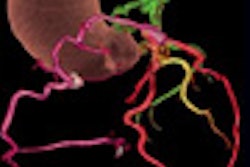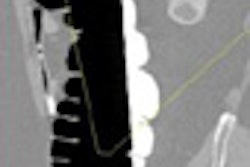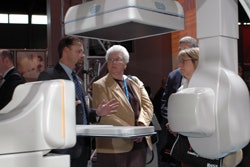Two major cautionary notes attached to coronary CT angiography (CTA) -- still a relatively new modality for evaluating coronary artery disease -- are the scarcity of literature proving a benefit in patients at risk of coronary artery disease (CAD), and its high radiation dose topping out at 10-12 mSv for a single exam -- about four years' annual background radiation.
Researchers at UCLA-Harbor Medical Center in Torrance, CA, believe they've gone a long way toward conquering both limitations with a low-dose 64-slice CT exam protocol and participation in several new studies suggesting a high prognostic value for CTA studies.
"We're acquiring CTA at 2 mSv sometimes even less than 1 mSv, and I think it takes away the greatest argument against the technology: that it affords a significant radiation dose and therefore should be used sparingly," said Dr. Matthew Budoff, an associate professor of medicine at the University of California, Los Angeles, and director of cardiology at Harbor-UCLA Medical Center.
In a telephone interview with AuntMinnie.com, Budoff discussed several studies presented in November at the American Heart Association (AHA) meeting in Orlando, FL. All of the studies examined mortality and the prognostic value of CTA, with images acquired using a low-dose step-and-shoot CTA protocol when possible.
As for the prognostic benefits of the CTA, one study at Harbor-UCLA's Los Angeles Biomedical Research Institute demonstrated an association between obstructive coronary artery disease at CTA and all-cause mortality in nearly 3,000 patients.
"I think that it confirms our understanding of coronary atherosclerosis and severity of disease, correlates very well with the old angiographic data -- that the more vessels involved the higher the mortality -- and I think it adds important prognostic information to a very good diagnostic test," Budoff told AuntMinnie.com.
Another study the group presented looked at a smaller cohort followed for a shorter time but more closely. The results showed essentially the same relationship between coronary artery stenosis (defined as luminal the presence of stenosis greater than 50% in an epicardial vessel) and cardiovascular mortality, the risk of death increasing with each additional stenosed vessel CTA detected.
Additional CTA studies presented at the meeting confirmed associations between left main artery obstruction, thoracic aortic calcification, and death.
Mortality versus disease severity
This retrospective study led by Dr. Matthew Ostrum, Budoff and colleagues sought to examine the relationship between all-cause mortality and the degree of coronary artery disease.
"While there is extensive literature on mortality incidence with respect to the degree of CAD defined by conventional angiography and coronary artery calcification, no such outcome data exists for CTA," the authors wrote in an abstract.
In all, 2,971 consecutive patients who underwent coronary CTA were followed for a mean of 5 ± 2 years, with the longest follow-up at 12 years. Significant CAD was defined as luminal narrowing of an epicardial vessel of 50% or greater.
The researchers tracked U.S. National Death Index data using patients' Social Security numbers, and predicted all-cause mortality using multivariable Cox proportional hazards models. For this study, only the date of death and the number of stenosed vessels at CTA were known to the researchers, and the patients were not followed up, Budoff said.
In all, there were 102 deaths (3.4%), and the incidence of death was far higher among those with more stenosed coronary vessels at CTA:
Mortality rate among those studied with:
- 3-vessel disease 16% (13/84)
- 2-vessel disease 6.1% (8/135)
- 1-vessel disease 3.5% (12/347)
In addition, risk models (adjusted for age, gender, hypertension, hypercholesterolemia, diabetes, family history of early heart disease, smoking and ethnicity) detailed the increasing risk associated with each additional coronary artery lesion, according to Budoff.
|
Patients with increasing severity of both obstructive and nonobstructive coronary artery disease at CTA were more likely to die over the subsequent follow-up period. The group concluded that the severity of disease correlates independently with all-cause mortality.
Taking into account the limited information that was available for the study, all-cause mortality is not a bad yardstick, Budoff said.
"All-cause mortality is about the most important end point," Budoff said. "Alive or dead is the most important answer that a doctor (gives) and a patient hopefully will be asking."
The group could have analyzed cardiovascular deaths rather than all-cause mortality, but that approach is problematic as well, Budoff said. When a patient dies suddenly of unknown causes it's classified as sudden death -- therefore cardiac-related -- even though the actual cause might not have been cardiac.
"When somebody dies of a pulmonary embolism or another catastrophic event, say a hemorrhagic stroke, they could die suddenly and that would not be a cardiac cause," though it would be counted as one, he said. And autopsy is rare.
"Using all-cause mortality is thought to be a better end point for these trials, so while we could have gone further and looked up the cause-specific mortality, we thought that might even weaken the overall results."
CTA patients followed 40 months
Another study from Budoff's team led by Dr. Naser Ahmadi sought to assess the prognostic accuracy of coronary CTA in symptomatic patients with an intermediate risk of CAD. The first clinical outcomes at 40 months' follow-up are included in the report presented at AHA, Budoff said.
In all, the group scanned 493 outpatients (69% male, mean age 58 ± 15 years) referred for CTA, excluding those with prior cardiovascular events or revascularizations, and followed them for a mean 40 ± 9 months. All cardiac events were defined as myocardial infarction or cardiovascular death.
Of the 493 patients, 157 (32%) had a normal study 204 (41%) had nonobstructive coronary artery disease, and 39 (8%) had at least one major nondiagnostic segment at CTA. In all, 89% of patients with obstructive disease and 12% of those with nondiagnostic CTA exams underwent catheterization.
Follow-up revealed 20 myocardial infarctions in patients with obstructive disease at CTA, one myocardial infarction in a case in which CTA was nondiagnostic, and none in which CTA was negative, the group reported. Survival over the follow-up period was 100%.
The Cox regression model, adjusted for age, gender, diabetes, hypertension, hypercholesterolemia, and coronary artery calcification, showed that obstructive disease diagnosed at CTA was a "strong independent predictor of cardiac events" (hazard radio =16.6, 95% CI = 4.9-55.2, p = 0.0001), the authors wrote in their abstract.
The results showed that obstructive coronary artery disease was associated with a 16-fold increase in the risk of experiencing a cardiac event over a 40-month period.
The results are in line with the larger study of 3,000 patients that used all-cause mortality as its end point, Budoff said.
"There are slightly different end points and lessons to be learned, but I think you see quite a bit of similarity with regard to the outcome data," he said. As for the cohort, they will continue to be carefully tracked for recanalization, stents, catheters, and adverse events.
"This is our initial look at the data; we're expanding that in time as well as in the number of patients," Budoff said.
Left main artery calcium signifies poor prognosis
A third study, led by Budoff's colleague Dr. Raveen Pal, used the same cohort of 493 symptomatic outpatients to evaluate the prognosis over a mean of 40 months for patients with left main (LM) artery calcification. Coronary artery calcium (CAC) scores were also obtained for each patient.
The group examined the risk of LM artery obstruction by assessing the hazard risk of significant CAC in each vessel including the LM, left circumflex (LCx), left anterior descending (LAD), and right coronary arteries (RCA).
This time the hazard risk was adjusted for age, gender, diabetes -- and significant CAC, significant LM CAC, significant LAD CAC, and significant RCA CAC.
According to the results, calcification of the LM artery was associated with a 9.75-fold increase in the risk of having a cardiac event, more than four times higher than the risk for other coronary arteries.
|
"This finding establishes LM CAC as a strong prognostic tool," the group concluded.
Thoracic aorta calcification
Less striking than left main calcification but still potent was the association of thoracic aorta calcification (TAC) to all-cause mortality. This study included 8,418 asymptomatic patients (69% male, mean age 53 ± 10 years) and was led by Dr. Khurram Nasir from Massachusetts General Hospital in Boston.
Budoff's group participated in association with eight other U.S. institutions, including Emory University in Atlanta, Ohio State University in Columbus, Johns Hopkins University in Baltimore, and the University of Pittsburgh in Pennsylvania.
After undergoing risk-factor evaluation, calcium testing with electron beam CT and coronary CTA, the patients were followed for a mean of 5.0 years. They used multivariable Cox proportional hazards model to predict all-cause mortality from the U.S. National Death Index.
Over five years, 141 (2%) deaths were recorded. The overall survival was 96.7% and 98.8% for patients with and without detectable TAC (p < 0.0001), the researchers reported. According to the unadjusted analysis, the mortality hazard ratio for subjects with TAC was 3.07 (95% CI: 2.20-4.3). After adjusting for age, gender, and cardiovascular risk factors, the association was reduced to 1.77 (95% CI: 1.11-2.29).
Significantly, even after adjusting for coronary artery calcium, the association between TAC and mortality endured, "although TAC appeared to predict events more strongly in the absence of CAC (HR: 2.81; 95% CI: 1.17-6.79, p = 0.02) than with CAC greater than 0 (HR: 1.39; 95% CI: 0.93-2.08, p = 0.10)," the authors reported. Still, interaction between TAC and CAC for mortality was insignificant (p = 0.23).
The presence of thoracic aorta calcium was associated with all-cause mortality, "and the relationship was independent of cardiovascular disease risk factors and coronary artery calcium," the authors concluded.
Step-and-shoot cuts dose for most
Budoff said that all CTA exams at Harbor-UCLA are performed using one of two 64-slice LightSpeed VCT scanners (GE Healthcare, Chalfont St. Giles, U.K.), with a third unit on the way.
The step-and-shoot acquisition algorithm developed by Hsieh et al significantly reduces exposure of the anatomy to multiple passes of the x-ray beam, in part by predicting heart rate variability rather than overscanning to compensate for it.
Hsieh's algorithm, the application of which is proprietary to GE's 64-slice VCT scanner, overcomes the longitudinal truncation problem that results from the CT scanner's conebeam geometry, minimizing the overlap in anatomic coverage between scans while providing robust ECG gating.
About 75% of patients undergoing CTA at UCLA-Harbor can be imaged with step-and-shoot, reducing the radiation dose to 2 mSv or less, Budoff, said. Another 20% of CTA patients presenting with persistently rapid heartbeat or significant variability can still be imaged on the scanner via traditional retrospective gating, yielding typical CTA radiation doses of about 12 mSv. The scans are acquired at 0.625-mm collimation, he said.
"Over 95% of patients can get cardiac CTA," Budoff said. "The biggest issues are afibrillation or persistent tachycardias, which make up less than 5% of the population."
The group has a study in press that will discuss 80% dose reduction with step-and shoot, Budoff said. If the patient's heart rate is variable, step-and-shoot allows the dose to be increased as needed -- for example, to the level of a 70% dose reduction.
How is the step-and-shoot protocol varied for different CTA patients? The scanner "basically triggers off the R-wave at approximately 70% of the RR interval; there's a phase range that gets narrow or wide," Budoff said. "If it's narrower, there's a radiation reduction. When the heart rate is variable, we use a wider phase range."
By Eric Barnes
AuntMinnie.com staff writer
December 7, 2007
Related Reading
MDCT may trump whole-heart cardiac MR for detecting stenosis, November 6, 2007
MDCT promising for long-term prognosis in patients with chest pain, November 5, 2007
Strong familial aggregation seen with left main coronary artery disease, October 16, 2007
Coronary CTA results correlate with all-cause mortality, June 19, 2007
Radiation dose slashed in 64-slice coronary CTA, February 15, 2007
Copyright © 2007 AuntMinnie.com



















